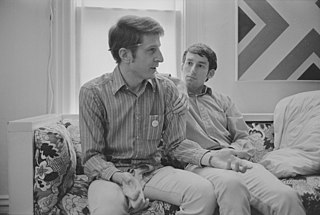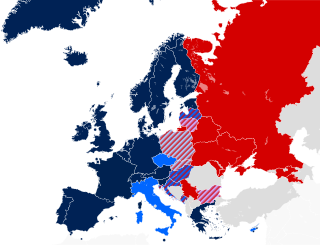
A civil union is a legally recognized arrangement similar to marriage, created primarily as a means to provide recognition in law for same-sex couples. Civil unions grant some or all of the rights of marriage.
A domestic partnership is an intimate relationship between people, usually couples, who live together and share a common domestic life but who are not married. People in domestic partnerships receive legal benefits that guarantee right of survivorship, hospital visitation, and other rights.

The availability of legally recognized same-sex marriage in the United States expanded from one state (Massachusetts) in 2004 to all fifty states in 2015 through various court rulings, state legislation, and direct popular votes. States each have separate marriage laws, which must adhere to rulings by the Supreme Court of the United States that recognize marriage as a fundamental right guaranteed by both the Due Process Clause and the Equal Protection Clause of the Fourteenth Amendment to the United States Constitution, as first established in the 1967 landmark civil rights case of Loving v. Virginia.

Mary Carolyn "Jodi" Rell is an American former politician who served as the 87th governor of Connecticut from 2004 to 2011. Rell also served as the state's 105th lieutenant governor of Connecticut from 1995 to 2004 under Governor John G. Rowland, and became governor after Rowland resigned from office. She remains the most recent Republican governor of Connecticut.
Same-sex marriage has been legal in Vermont since September 1, 2009. Vermont was the first U.S. state to introduce civil unions on July 1, 2000, and the first to introduce same-sex marriage by enacting a statute without being required to do so by a court decision. Vermont was the fourth state to legalize same-sex marriage after Massachusetts, Connecticut, and Iowa.
Same-sex marriage has been legally recognized in New Jersey since October 21, 2013, the effective date of a trial court ruling invalidating the state's restriction of marriage to persons of different sexes. In September 2013, Mary C. Jacobson, Assignment Judge of the Mercer Vicinage of the Superior Court, ruled that as a result of the U.S. Supreme Court's June 2013 decision in United States v. Windsor, the Constitution of New Jersey requires the state to recognize same-sex marriages. The Windsor decision held that the federal government was required to provide the same benefits to same-sex couples who were married under state law as to other married couples. Therefore, the state court reasoned in Garden State Equality v. Dow that, because same-sex couples in New Jersey were limited to civil unions, which are not recognized as marriages under federal law, the state must permit civil marriage for same-sex couples. This ruling, in turn, relied on the 2006 decision of the New Jersey Supreme Court in Lewis v. Harris that the state was constitutionally required to afford the rights and benefits of marriage to same-sex couples. The Supreme Court had ordered the New Jersey Legislature to correct the constitutional violation, by permitting either same-sex marriage or civil unions with all the rights and benefits of marriage, within 180 days. In response, the Legislature passed a bill to legalize civil unions on December 21, 2006, which became effective on February 19, 2007.

The Connecticut Supreme Court, formerly known as the Connecticut Supreme Court of Errors, is the highest court in the U.S. state of Connecticut. It consists of a Chief Justice and six Associate Justices. The seven justices sit in Hartford, across the street from the Connecticut State Capitol. The court generally holds eight sessions of two to three weeks per year, with one session each September through November and January through May. Justices are appointed by the governor and then approved by the Connecticut General Assembly.
Same-sex marriage has been legally recognized in the US state of Washington since December 6, 2012. On February 13, 2012, Governor Christine Gregoire signed legislation that established full marriage rights for same-sex couples in the state of Washington. Opponents mounted a challenge that required voters to approve the statute at a referendum, which they did on November 6. The law took effect on December 6, and the first marriages were performed on December 9. Within a couple of days, more than 600 marriage licenses were issued to same-sex couples in King County alone.
Same-sex marriage has been legally recognized in Maryland since January 1, 2013. In 2012, the state's Democratic representatives, led by Governor Martin O'Malley, began a campaign for its legalization. After much debate, a law permitting same-sex marriage was passed by the General Assembly in February 2012 and signed on March 1, 2012. The law took effect on January 1, 2013 after 52.4% of voters approved a statewide referendum held on November 6, 2012. The vote was hailed as a watershed moment by gay rights activists and marked the first time marriage rights in the United States had been extended to same-sex couples by popular vote.
Same-sex marriage has been legally recognized in Wisconsin since October 6, 2014, upon the resolution of a lawsuit challenging the state's ban on same-sex marriage. On October 6, the U.S. Supreme Court refused to hear an appeal of an appellate court ruling in Wolf v. Walker that had found Wisconsin's ban on same-sex marriage unconstitutional. The appellate court issued its order prohibiting enforcement of the state's ban on same-sex marriage the next day and Wisconsin counties began issuing marriage licenses to same-sex couples immediately. Wisconsin had previously recognized domestic partnerships, which afforded limited legal rights to same-sex couples, from August 2009 until they were discontinued in April 2018.
Same-sex marriage has been legal in New Hampshire since January 1, 2010, based on legislation signed into law by Governor John Lynch on June 3, 2009. The law provided that civil unions, which the state had established on January 1, 2008, would be converted to marriages on January 1, 2011, unless dissolved, annulled, or converted to marriage before that date.
Same-sex marriage has been legal in Ecuador since 8 July 2019 in accordance with a Constitutional Court ruling issued on 12 June 2019 that the ban on same-sex marriage was unconstitutional under the Constitution of Ecuador. The ruling took effect upon publication in the government gazette on 8 July. Ecuador became the fifth country in South America to allow same-sex couples to marry, after Argentina, Brazil, Uruguay and Colombia, but adoption by married couples remains restricted to opposite-sex couples. The country has also recognized same-sex civil unions since 2008.
Peter T. Zarella is a former Associate Justice of the Connecticut Supreme Court. Zarella sat on the court he was appointed by Governor John G. Rowland in January 2001 until his retirement on December 31, 2016.
Kerrigan v. Commissioner of Public Health, 289 Conn. 135, 957 A.2d 407, is a 2008 decision by the Connecticut Supreme Court holding that allowing same-sex couples to form same-sex unions but not marriages violates the Connecticut Constitution. It was the third time that a ruling by the highest court of a U.S. state legalized same-sex marriage, following Massachusetts in Goodridge v. Department of Public Health (2003) and California in In re Marriage Cases (2008). The decision legalized same-sex marriage in Connecticut when it came into effect on November 12, 2008. There were no attempts made to amend the state constitution to overrule the decision, and gender-neutral marriage statutes were passed into law in 2009.

Lesbian, gay, bisexual, and transgender (LGBT) people in the Cayman Islands may face legal challenges not experienced by non-LGBT residents. Both male and female types of same-sex sexual activity are legal in the Cayman Islands. Despite anti-gay attitudes expressed by certain members of the government, social acceptance by the Caymanian public has been known to be some of the best in the Caribbean. Some have attributed this to the strong British influence in the territory.

Debate has occurred throughout Europe over proposals to legalise same-sex marriage as well as same-sex civil unions. Currently 33 of the 50 countries and the 8 dependent territories in Europe recognise some type of same-sex union, among them most members of the European Union (24/27). Nearly 43% of the European population lives in jurisdictions where same-sex marriage is legal.
Same-sex marriage has been legal in Arizona since October 17, 2014. The U.S. state had denied marriage rights to same-sex couples by statute since 1996 and by an amendment to its State Constitution approved by voters in 2008. On October 17, Judge John W. Sedwick ruled in two lawsuits that Arizona's ban on same-sex marriage was unconstitutional, and enjoined the state from enforcing its ban, effective immediately. Attorney General Tom Horne said the state would not appeal that ruling, and instructed county clerks to comply and issue marriage licenses to same-sex couples.
Mary L. Bonauto is an American lawyer and civil rights advocate who has worked to eradicate discrimination based on sexual orientation and gender identity, and has been referred to by US Representative Barney Frank as "our Thurgood Marshall." She began working with the Massachusetts-based Gay & Lesbian Advocates & Defenders, now named GLBTQ Legal Advocates & Defenders (GLAD) organization in 1990. A resident of Portland, Maine, Bonauto was one of the leaders who both worked with the Maine legislature to pass a same-sex marriage law and to defend it at the ballot in a narrow loss during the 2009 election campaign. These efforts were successful when, in the 2012 election, Maine voters approved the measure, making it the first state to allow same-sex marriage licenses via ballot vote. Bonauto is best known for being lead counsel in the case Goodridge v. Department of Public Health which made Massachusetts the first state in which same-sex couples could marry in 2004. She is also responsible for leading the first strategic challenges to section three of the Defense of Marriage Act (DOMA).

The establishment of lesbian, gay, bisexual, and transgender (LGBT) rights in the U.S. state of Connecticut is a recent phenomenon, with most advances in LGBT rights taking place in the late 20th century and early 21st century. Connecticut was the second U.S. state to enact two major pieces of pro-LGBT legislation; the repeal of the sodomy law in 1971 and the legalization of same-sex marriage in 2008. State law bans unfair discrimination on the basis of sexual orientation and gender identity in employment, housing and public accommodations, and both conversion therapy and the gay panic defense are outlawed in the state.
This article contains a timeline of significant events regarding same-sex marriage in the United States. On June 26, 2015, the landmark US Supreme Court decision in Obergefell v. Hodges effectively ended restrictions on same-sex marriage in the United States.






